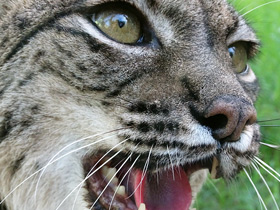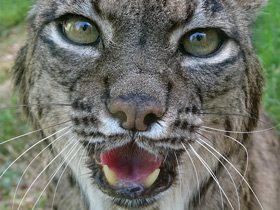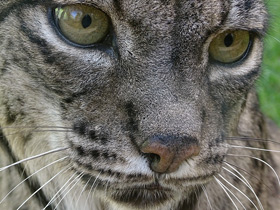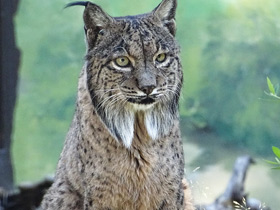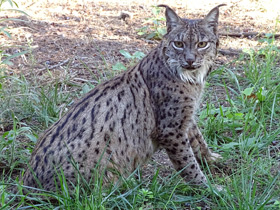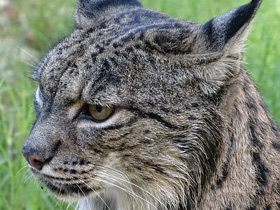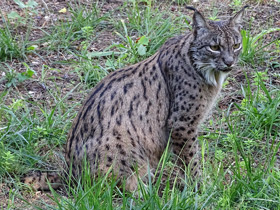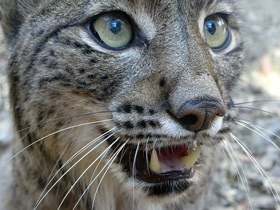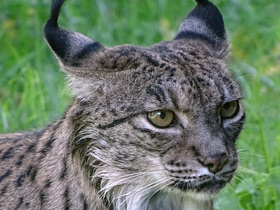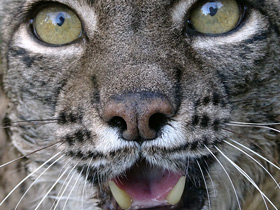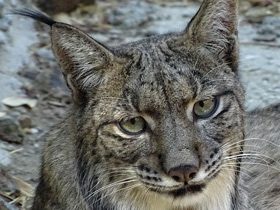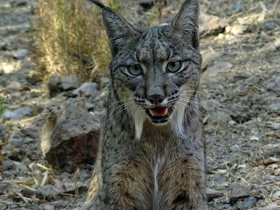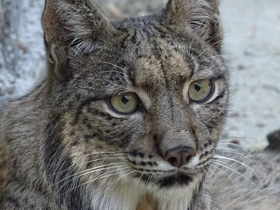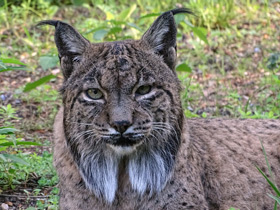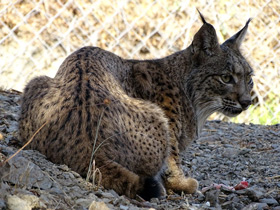The Iberian lynx (Lynx pardinus)
 The Iberian lynx (Lynx pardinus) is included in the IUCN Red List as an "endangered species"
The Iberian lynx (Lynx pardinus) is included in the IUCN Red List as an "endangered species"
The Iberian lynx (Lynx pardinus) is one of the four extinct species within the medium-sized wild cat genus Lynx. It is endemic to the Iberian Peninsula in southwestern Europe. It is listed as Endangered on the IUCN Red List. In the 20th century, the Iberian lynx population had declined because of overhunting, poaching, fragmentation of suitable habitats, and the population decline of its main prey species, the European rabbit (Oryctolagus cuniculus), caused by myxomatosis and rabbit haemorrhagic disease.
It is a monotypic species, and is thought to have evolved from Lynx issiodorensis.
Taxonomy
Felis pardina was the scientific name proposed by Coenraad Jacob Temminck in 1827 who described skins of Iberian lynxes that were killed in the area of the Tagus river in Portugal and were traded in Paris and London. It is a monotypic species.
Appearance
Lynx pardinus is a species of carnivorous mammal of the family Felidae, endemic to the Iberian Peninsula, internationally known for its recovery from being critically endangered in the early 21st century.
Lynx pardinus was previously considered a subspecies of the common lynx. It has now been shown that they are two distinct species that evolved independently during the Pleistocene. Lynx pardinus is lighter in colour and has pronounced spots, resembling a leopard. Its coat length is slightly shorter than that of other lynxes, because the climate of its habitat is much milder. In winter, the coat of Lynx pardinus is slightly duller and thinner, which makes it appear less bulky.
In addition, Lynx pardinus is much smaller than the common lynx: its height at the withers varies from 45 to 70 cm, its body length varies from 75 to 100 cm and its short tail is between 12 and 30 cm. Males are larger than females and weigh about 13 kg on average, but some individuals can weigh up to 26 kg; the average weight of females is about 9.5 kg, which is about half the weight of the lynx.
Habitat area
Lynx pardinus is common in southwestern Spain (most of the population is in the Coto Doñana National Park), although it was widely distributed in Spain and Portugal until the mid-19th century. Today, the cat is only found in isolated areas of southern Spain, in Andalusia. It prefers to live among grasslands and farmland, near bushes and forests, being found mainly in mountainous areas and occasionally in lowland forests.
Lifestyle and nutrition
Apart from the breeding season, Lynx pardinus lead a solitary lifestyle, protecting their territory from outsiders. The size of this area varies between 10 (females) and 18 (males) km2. Plot boundaries may change over time and depending on the number of rabbits. The male's territory partially overlaps with several female plots and allows females to enter his territory. He marks the boundaries of his territory with scent marks, urine, faeces and scratches on tree bark.
The Lynx pardinus is a specialised hunter, and has a number of characteristics that allow it to catch and kill small prey with dexterity. It has a short skull, which maximises the bite force of its tusks. The Lynx pardinus has a narrower snout, longer jaws and shallower tusks than animals that feed on larger prey. The Pyrenean lynx preys mainly on European rabbits, which make up the majority of its diet (79-87%), hares (14-6%) and rodents (7-3%). A male rabbit needs to eat one rabbit per day; a lactating female needs about three rabbits per day. Lynx pardinus also hunts reptiles and amphibians, birds, fish and insects; it sometimes attacks young roe deer or deer.
Lynx pardinus is active at night in the warm season and during the day in winter. In inclement weather, it hides in caves or crowded trees. The lynx runs well, and its eyesight and sense of smell are well developed, allowing it to detect its prey at a distance of up to 300 m. This predator can walk up to seven kilometres a day (when hunting). Lynx pardinus usually hunts from ambush, lurking on a tree branch or behind a stump or rock, waiting until its prey gets close enough to attack. The captured prey Lynx pardinus moves a short distance away from the killing site and only then begins to eat it. The uneaten portion is left for the next day.
Lynx pardinus was previously considered a subspecies of the common lynx. It has now been shown that they are two distinct species that evolved independently during the Pleistocene. Lynx pardinus is lighter in colour and has pronounced spots, resembling a leopard. Its coat length is slightly shorter than that of other lynxes, because the climate of its habitat is much milder. In winter, the coat of Lynx pardinus is slightly duller and thinner, which makes it appear less bulky.
In addition, Lynx pardinus is much smaller than the common lynx: its height at the withers varies from 45 to 70 cm, its body length varies from 75 to 100 cm and its short tail is between 12 and 30 cm. Males are larger than females and weigh about 13 kg on average, but some individuals can weigh up to 26 kg; the average weight of females is about 9.5 kg, which is about half the weight of the lynx.
Habitat area
Lynx pardinus is common in southwestern Spain (most of the population is in the Coto Doñana National Park), although it was widely distributed in Spain and Portugal until the mid-19th century. Today, the cat is only found in isolated areas of southern Spain, in Andalusia. It prefers to live among grasslands and farmland, near bushes and forests, being found mainly in mountainous areas and occasionally in lowland forests.
Lifestyle and nutrition
Apart from the breeding season, Lynx pardinus lead a solitary lifestyle, protecting their territory from outsiders. The size of this area varies between 10 (females) and 18 (males) km2. Plot boundaries may change over time and depending on the number of rabbits. The male's territory partially overlaps with several female plots and allows females to enter his territory. He marks the boundaries of his territory with scent marks, urine, faeces and scratches on tree bark.
The Lynx pardinus is a specialised hunter, and has a number of characteristics that allow it to catch and kill small prey with dexterity. It has a short skull, which maximises the bite force of its tusks. The Lynx pardinus has a narrower snout, longer jaws and shallower tusks than animals that feed on larger prey. The Pyrenean lynx preys mainly on European rabbits, which make up the majority of its diet (79-87%), hares (14-6%) and rodents (7-3%). A male rabbit needs to eat one rabbit per day; a lactating female needs about three rabbits per day. Lynx pardinus also hunts reptiles and amphibians, birds, fish and insects; it sometimes attacks young roe deer or deer.
Lynx pardinus is active at night in the warm season and during the day in winter. In inclement weather, it hides in caves or crowded trees. The lynx runs well, and its eyesight and sense of smell are well developed, allowing it to detect its prey at a distance of up to 300 m. This predator can walk up to seven kilometres a day (when hunting). Lynx pardinus usually hunts from ambush, lurking on a tree branch or behind a stump or rock, waiting until its prey gets close enough to attack. The captured prey Lynx pardinus moves a short distance away from the killing site and only then begins to eat it. The uneaten portion is left for the next day.
Reproduction
The kittens become independent at 7 to 10 months old, but remain with the mother until around 20 months old. Survival of the young depends heavily on the availability of prey species. In the wild, both males and females reach sexual maturity at the age of one year, though in practice they rarely breed until a territory becomes vacant; one female was known not to breed until five years old when its mother died. The maximum longevity in the wild is 13 years.
Difficulty in finding mates has led to more inbreeding, which results in fewer kittens and a greater rate of non-traumatic death. Inbreeding leads to lower semen quality and greater rates of infertility in males, hindering efforts to increase the species' fitness.
Threats
The Iberian lynx is threatened by habitat loss, road accidents, and illegal hunting. Habitat loss is due mainly to infrastructure improvement, urban and resort development and tree mono cultivation, which fragments the lynx's distribution. In the 20th century, rabbit diseases such as myxomatosis and hemorrhagic disease resulted in a dramatic decline of its main prey. Illegal traps set for rabbits and foxes were the leading causes for lynx mortality in the 1990s. Every year, several Iberian lynxes die when trying to cross highways with heavy traffic. In 2013, 14 Iberian lynxes died on roads, and 21 in 2014.
In 2007, several individuals died of feline leukemia.
Increasing interactions with humans and spread of antibiotic resistant genes between lynx populations could pose a significant threat not only to lynx but also to humans.
Conservation
The Iberian lynx is fully protected. It is listed on CITES Appendix I, on Appendix II of the Berne Convention on the Conservation of European Wildlife and Natural Habitats and on Annexes II and IV of the Habitats Directive of the European Union. It has been listed as Endangered on the IUCN Red List since 2014.
Conservation measures include restoring its native habitat, maintaining the wild rabbit population, reducing unnatural causes of death, and releasing captive bred individuals. The Spanish National Commission for the Protection of Nature endorsed the Iberian Lynx Ex Situ Conservation Breeding Program to serve as a "safety net" by managing the captive population and also to "help establish new Iberian lynx free-ranging populations through reintroduction programmes." Before release of captive-bred cats, their natural habit may be simulated to prepare them for life in the wild. A 2006 study used a non-intrusive monitoring system involving cameras to monitor the demographics of both lynxes and rabbits residing in Sierra Morena. Supplemental food sources could be provided if wild rabbits suffered a decline.
Management efforts are being developed to conserve and restore the animal's native range. Officials intending to release captive-bred lynx look for areas of appropriate habitat, rabbit abundance, and acceptance by the local human population. About 90 million euros was spent on various conservation measures between 1994 and 2013. The European Union contributes up to 61% of funding.

















